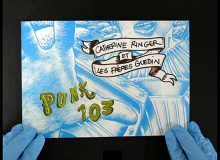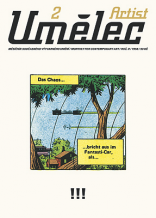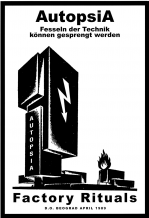| Umělec magazine 2003/2 >> Metropolis of Silence (Ryuta Amae) | List of all editions. | ||||||||||||
|
|||||||||||||
Metropolis of Silence (Ryuta Amae)Umělec magazine 2003/201.02.2003 Linda Fournier | profile | en cs |
|||||||||||||
|
“Synthetic image” is an expression used to describe a painted image numerically processed via informatics. Because it is held in coded form in the memory of the computer — on a magnetic tape or on an optical disc — it is unreadable to the human eye, unless in a projection on a cathode screen, or some other graphic receiver. The so-called pixels, or basic units of color image, carry light intensity in the superposition of three color layers (red, green and blue) and in a supplementary system, called rgb. Because of the rapid increase in the number of computer programs and software since the 1960’s, techniques of the synthetic image have developed quickly, and the practical techniques of independent artworks and their animation abilities are improving.
Japanese artist Ryuta Amae has been living in France since 1987. After studying art at the academies in Tokyo and Paris, he focused on working in new media. Art lovers have categorized him as a numerical photographer, but Amae himself doesn’t fully agree with this label and explains: “I’m not a photographer. The public is confused by the authenticity of my works, to the extent that they consider it a photograph. However, my artistic methods are much closer to painting than to photography.” So is he the author of numerically processed images? The progress of technology is such that soon the PC mouse will replace the paintbrush, and the computer screen, the easel. Slowly, the time of abstract works with large-surface color (like Jeremy Blake’s) or virtual “high/tech” graphic worlds (like Amae’s), is coming. Ryuta Amae only archives his sketches and drafts for two or three months. During this time, he zealously creates an environment, which, with the help of exact mathematical data, reproduces the reality “more realistically than is the reality itself.” “Photomontage doesn’t interest me. It is only a sophisticated version of handmade collage,” explains Amae, who creates a perfect world, some kind of 3-D models, 90 percent of which is fictitious material. For these ideal microcosms, he chooses a particular point of view, which is the only analogy between Amae’s work and photographic methods. The virtual negative becomes a large-format, 2-D image, usually 2 x 2 m. The influence of Japanese culture can be recognized in his foolish grandeur, and in his placement of megalomaniac architectonic constructions into empty space, as, for example, in Fiction. This work is a bluish specter of fragmental architecture, unfinished cosmopolitan construction, unfolding urbanity. “Free of all weightlessness,” the steel construction of a metropolis of silence, which is disturbed from its structural rhythm. On the contrary, Hypnotic discovers the traditional soberness of the Japanese landscape. Amae records on the extremely shiny surface of the paper “yamato-e” (a genre of Japanese painting) an ancient Japanese garden, through which flows clear water. The evanescent moment of eternity or the expression wabi, voicing calmness and simplicity, invites us to moments of tranquility and meditation, so characteristic for the country of the rising sun. The oriental line is again updated through special effects into the playful estheticism of Manga, as seen in Pro Drome 1, where a futuristic sculptured mountain of aluminum reflections emerges out of wild grass. Amae’s method is innovative because the picture is transferred to 35mm film or some other surface with photographic emulsion. “While the technique is still developing, I consider my duty to be professionally and artistically of a very high standard,” adds Amae, the creator of dreamy paradises with the touch of deja vu, catching their invisible presence in the collective unconscious. As a dutiful dramatist, he creates a “context” with no place for randomness, as the public “is not ready to accept imperfection. Photography as a discipline hasn’t reached perfection, as Nan Goldin or Araki tried to achieve in the experiments with photographic material, with unusual sharpness, or with the over-exposition or the incorrect adjustment of the camera.” The photo Eden is a look at green fields with palms, sea and atmosphere returning to the primary conception of utopia, although there are marks and traces of non-reality, rising doubts about this “too” perfect landscape. Amae’s images create some kind of loop, which plays with reality as an expression, while the viewer has the impression that the deviations are in fact more trustworthy than the absurd omnipresence of the real world. The artist investigates the phenomenon of shift, some kind of a fairy tale space “between two worlds,” a kind of pause to think about the picture, when all the senses convulse, as if in some hidden parallel world, where everything seems so “normal,” but where we look for the errors and imperfections that are involuntarily included in this system. If we proceed from the assumption that the photography cannot be “true,” as claims Andreas Gursky, who focused in his work on the perspective of non-existing places and on manipulation through informatics, the more we have to develop artistic worlds, says Amae. He himself pauses to think about this principle, and then specifies that “the truth doesn’t lie in the trial, but in the testimony of presence in the given moment.” Thus he avoids the physical limitation of “being in a place,” and reverses the perception of photographic patterns and methods. While photographer attempts to catch accidental interception, Amae has the power to create the accident himself through his hyper-realistic direction. According to the credo “I make theater, I offer situations.” This is how he progresses, and at the same time manages to resist inappropriate subjectivity. What should we think of the work This Is Not Nike, a detail of a shoe with an ironic and anti-consumer slogan, which recalls Magritt’s This Is Not a Pipe, in itself pointing to the defectiveness of the relation between the language and the representation of reality? “The world is not good nor bad, I am content to show it.” His impartiality shows more ways of interpreting a work, enabling the viewer to perceive them freely. This dimension of mystery opens Amae’s work to the outer world, free of all judgement, of discussions, which it necessarily activates in us, from the innocent questions that call for countless answers. Amae’s last exhibition, titled Computer Generated Photography, in Gallery Michel Rein in Paris attempts to avoid the urge to perceive things one way: “People seem to have forgotten that these are synthetic pictures, although they already understood and got accustomed to my artistic methods.” That is why Amae comes with clearly virtual landscapes, to shake up the public without feeling the necessity to justify himself because of this, as for example in Pro Drome II., where in the foreground we see the famous shoe, set in a moonscape. “I decided to put in the foreground what we usually try to hide, which is the technical process of the work,” says Amae. By his choice of means, uses the processes which were chosen for the exhibition presentation of the works of William Eggleton, titled Color Photography by William Eggleton. Eggleton is a pioneer of color photography, because he raised mass media to the level of art. In the United States, this art discipline has long been assigned to stereotypical pin-up style or advertisements, and was put in contrast to art photography, exclusively black and white. Informatics, computers and synthetic images are generally considered a part of pop culture. Amae turns away from the arbitrary basics of elitist pseudo-art, and emphasizes the innovative means in new technologies through his seemingly professional skills, and his more than imaginary creativity, enabling him to create chimerical visions with a prophetic air.
01.02.2003
Recommended articles
|
|||||||||||||
|
04.02.2020 10:17
Letošní 50. ročník Art Basel přilákal celkem 93 000 návštěvníků a sběratelů z 80 zemí světa. 290 prémiových galerií představilo umělecká díla od počátku 20. století až po současnost. Hlavní sektor přehlídky, tradičně v prvním patře výstavního prostoru, představil 232 předních galerií z celého světa nabízející umění nejvyšší kvality. Veletrh ukázal vzestupný trend prodeje prostřednictvím galerií jak soukromým sbírkám, tak i institucím. Kromě hlavního veletrhu stály za návštěvu i ty přidružené: Volta, Liste a Photo Basel, k tomu doprovodné programy a výstavy v místních institucích, které kvalitou daleko přesahují hranice města tj. Kunsthalle Basel, Kunstmuseum, Tinguely muzeum nebo Fondation Beyeler.
|

































 We Are Rising National Gallery For You! Go to Kyjov by Krásná Lípa no.37.
We Are Rising National Gallery For You! Go to Kyjov by Krásná Lípa no.37.
Comments
There are currently no comments.Add new comment